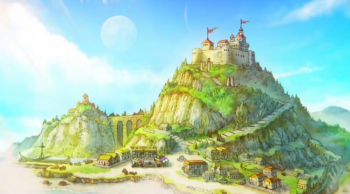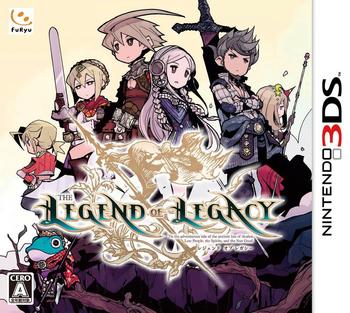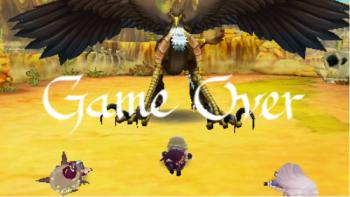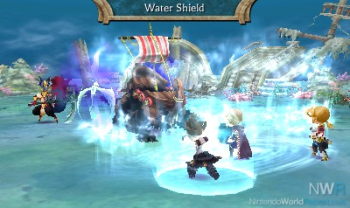Legend of Legacy: Laborious
Atlus has been one of the major players in getting unique and interesting RPGS onto the various Nintendo handhelds over the years: From the recent side stories of Shin Megami Tensei, to my personal favorite, the Etrian Odyssey series. However, not all of them can hook me, and today’s game Legend of Legacy is a case where thinking outside the box proved to be its undoing.
 Legend of Legacy starts out as most JRPGs (Japanese role playing games) do: Mysterious setting, hidden treasures and a group of heroes on a quest, but the game quickly changes things up.
Legend of Legacy starts out as most JRPGs (Japanese role playing games) do: Mysterious setting, hidden treasures and a group of heroes on a quest, but the game quickly changes things up.
You can choose one person to be the main character at the start of the game, quickly meeting and teaming up with two other characters with the option to swap party members at anytime from the starting town.
The story is just a loose reason to go exploring, and the game allows you to skip cutscenes if you so choose. Similar to Etrian Odyssey, the main point of Legend of Legacy is to explore and build an effective party.
After a few minutes of play, you’ll find the other heroes in the starting town; allowing you to mix and match your three-person party however you choose. In a traditional JRPG, party members are hard-coded for specific tasks and abilities; locking their utility and determining where they can fit in a party. Legend of Legacy doesn’t do that, and instead breaks several conventions of the RPG genre.
Breaking the Rules
When it comes to RPGs, we all know that there are certain mechanics and rules that have become standard. If you’re playing a RPG, regardless of platform or style, you expect to level up your heroes, assign attribute and skill points, and generally have a rising curve of progression from start to end. Legend of Legacy has none of that; the game has no such thing as experience, character levels, or even what could be considered a normal progression curve.
Each character has three stats: Attack, Guard and Support; allowing them to hit harder, resist more damage or react quicker respectively. During combat, each character has a random chance during their move to become stronger in these areas based on their formation (more on that in a minute.) Characters will also randomly gain health and SP (used for special moves) upgrades.
Instead of classes, the weapon types themselves function as a “job” system. The more someone uses a specific weapon type, the greater the chance they’ll randomly level up the skill they used and their proficiency with that weapon, and will also randomly get new skills to use.
 There are two unique systems to Legend of legacy as well: Elemental contracts and formations. Formations allow you to set up your party in different positions; each position alters how that person responds in combat.
There are two unique systems to Legend of legacy as well: Elemental contracts and formations. Formations allow you to set up your party in different positions; each position alters how that person responds in combat.
Setting them in offense will raise their attack, while defense allows someone to block for the entire party and gets increased defense.
You can create new formations from the menu and set up arrangements however you want with your party. This system is important, because you will be fighting enemy parties bigger than yours; having the right tactics set up can mean all the difference.
As you play through the game, you’ll unlock the ability to receive aid from the elements; in turn, letting you use special skills and get buffs during combat. The system works by requiring you to use the “element contract” skill to summon the element on your side of the field; giving you the buff while it’s active. From there, anyone in your party can cast skills of that element type, provided they have the SP.
These skills start out locked to shards that can be found while exploring; using them will give you a random chance to learn the skill and use it without the shard. While you are summoning elements, the enemy can do that too; leading to tug of wars where both sides will try to deny the other their chosen elements.
All in all, these changes make Legend of Legacy a different beast compared to other JRPGs on the market. Most of the time, you’re not going to beat a boss through grinding out stats, but by properly managing your party and what skills to bring in. The game ties exploration in by unlocking new gear based on exploring new areas and filling up your map to sell it back in town.
While Legend of Legacy does a lot to downplay or eliminate the annoying tendencies of JRPGs, it’s not without its problems.
Aimlessness
 Some of my favorite RPGs have been those that do something different: Shin Megami Tensei, Resonance of Fate and the poster child: The World Ends With You. Each game removed or altered traditional RPG design and replaced it with their own unique take.
Some of my favorite RPGs have been those that do something different: Shin Megami Tensei, Resonance of Fate and the poster child: The World Ends With You. Each game removed or altered traditional RPG design and replaced it with their own unique take.
The major problem with Legend of Legacy is that while the designers have cut back on those JRPG elements, they didn’t replace them with enough new systems. Random progression is not a substitute for fixed progression and can be worse in some aspects.
Even though the game doesn’t want you to grind levels or experience, you still need to get into fights regardless.
The reason is that the only way to improve your stats and earn new abilities is through combat; even though the game tries to play up the importance of exploration.
If the player could improve their party in other ways, then the reliance of combat would be lessen, but you’re going to be in trouble if you don’t unlock the means to cast element skills without needing to equip their shards.
Despite the developers’ best efforts to remove grinding, it’s still an ever present force, but now randomized. Case in point: One of my party members unlocked three new skills for the short sword weapon type in two battles; meanwhile, the person I’m raising to use the axe took over 30 fights before unlocking her first move.
Speaking of skills and progression, the game does a bad job of explaining how stats and gear work. There were enemies who I was killing in one hit from my strongest fighter, to then face enemies in the same area who were shrugging off those attacks for no rhyme or reason. Each skill shows your three stats on the right hand side, however, the game doesn’t tell you what that means; not even in the manual.
 Looking at the skills I learned, a lot of them seemed weaker with no alternate functionality; bloating out the combat system in the worse way. A better alternative would have been to give the different weapons more functionality and abilities; letting the player fully customize their strategies along with the formation system.
Looking at the skills I learned, a lot of them seemed weaker with no alternate functionality; bloating out the combat system in the worse way. A better alternative would have been to give the different weapons more functionality and abilities; letting the player fully customize their strategies along with the formation system.
Enemy encounters were also imbalanced in areas. One fight may have you go up against two or three enemies; the next with six heavy enemies who can each kill a party member in one hit. Again, since there is no experience in the basic sense, there is no greater reason to fight a very hard battle in place of an easy or medium one.
Different attacks also made no sense in terms of damage output. There were cases where I would attack an enemy and do 60 points of damage, then the next hit would do 160 or vice versa for no reason. The same goes for enemy attacks; the same enemy who previous hit for 20 points of damage, his second attack type then hit for over 100, killing my character.
While the game is built around rewarding players for exploring the world, there is one annoying trend with the game’s escape feature. Enemies will wander around the environment and a battle will start if they come into contact. While you can run away from normal fights, boss enemies on the map prevent you from running away; even though they also sometimes wander around or attack via a proximity-triggered cutscene.
 It’s very easy to get caught unaware by a boss enemy, become stuck in a fight and then lose progress from the last save point.
It’s very easy to get caught unaware by a boss enemy, become stuck in a fight and then lose progress from the last save point.
Another point is that while running away is guaranteed outside of bosses, it sends you back to the start of the area; creating more grind having to get back to where you were, which is doubly annoying considering the difference in enemy groups that you can get.
The game does feature a quick save system which I suggest you use at the start of each area.
Two Steps Forward and Three Steps Back
Legend of Legacy does its best to present a JRPG without the hassle and annoying conventions of the genre, but in trying to fix those issues, the designers created new ones for the game.
While the traditional grind of experience points and leveling are absent, they’ve been replaced by random progression and an obtuse stat system. It’s a shame, as the underlining mechanics of exploration, formations and the elemental systems are great; becoming better as you progress. With that said, it’s been awhile since I’ve played a JRPG with this much in terms of confusing systems and inconsistent combat; which drove me away from the genre in the first place.
This is a perfect example of a game that forces you to find what’s good about it; the game doesn’t hold your hand at any point and leaves you to figure out the progression and mechanics. If the game clicks, you’re going to have an enjoyable time; if it doesn’t, expect to put this one down within minutes.
Josh Bycer is a Game Industry Analyst with more than seven years of experience writing and talking about game design and the industry. You can find his posts and weekly podcasts on Game-Wisdom along with his Patreon campaign to secure monthly funding. You can check out his YouTube Channel for daily plays; including a campaign run of the hit Rogue-like: Darkest Dungeon.
Atlus, through partners/sub companies have made some pretty good games that should appeal to fantasy fans.
Some I’d recommend –
1. Odin Sphere – classic PS2 game now getting ported (and improved) for PS3 and 4 – I pre-ordered mine. Nice rich color – using the graphics capabilities of modern games to handle 2d and 2.5D versus going polygon.
2. Dragon’s Crown – Perfect for Sword and Sorcery fans proper – kind of a tribute to classic arcade games like Golden Axe. Got a lot of SJW whine brigade attacks over some of the character designs. Oh, wow, A Japanese game makes stuff with Western style exaggeration vs quasi underage stuff they get for regular stuff, then the SJW’s screech at that too. But very fun game to play!
3. Abyss Odyssey – really neat 2D game with 3d background. Based on late Renaissance central america stuff. Pretty cheap on Steam